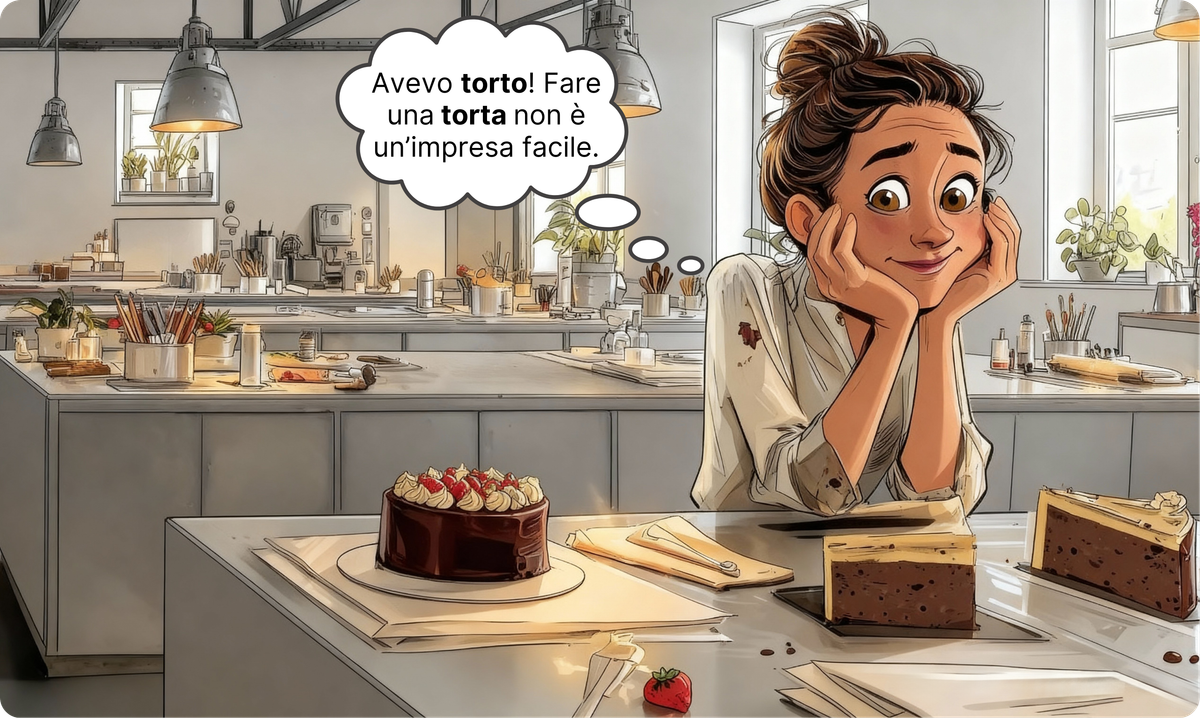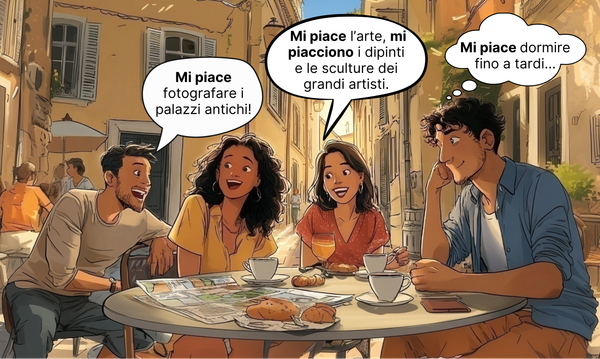Intro.
What's the difference between il panno and la panna? Or between il lama and la lama? They appear to be the masculine and feminine forms of the same word. Yet they're not. In the Italian language, some pairs of words that differ in gender have different meanings in masculine and feminine: this is the case of so-called false gender changes.
With this definition of "false gender changes", we mean words that seem to follow one of the main rules of Italian grammar: masculine in -o, feminine in -a for the same word, but actually represent two completely different concepts. Recognizing and memorizing (yes indeed, you need to memorize!) these deceptive word pairs is essential to avoid common errors or embarrassing situations and communicate with precision without causing uncertainty in those listening.
Let's look at some combinations of false gender changes below.
1. Italian Word Pairs in -o/-a with the Same Origin
These are pairs that share the same root (the initial part of the word) and for this reason maintain a connection, albeit slight, between them, meaning they recall a common idea. However, over time and in usage they have become autonomous words with different meanings in masculine and feminine.
• il corso and la corsa – Il corso (the course) is the flow, the path, but also a cycle of lessons. La corsa (the run/race) is the sport, the action of running. They have in common the meaning of a route.
Examples:
Frequento un corso di italiano.
I attend an Italian course.
La corsa aiuta a tenersi in forma.
Running helps to stay in shape.
• il pezzo and la pezza – Il pezzo (the piece) is a small part. La pezza (the cloth) is a piece of fabric (a cloth). What unites them is the meaning of being a part of something larger.
Examples:
A merenda ho mangiato un pezzo di crostata alle noci.
For a snack I ate a piece of walnut tart.
Ho usato una pezza di lana per pulire i gioielli.
I used a woolen cloth to clean the jewelry.
• il panno and la panna – Il panno (the cloth) is any type of fabric. La panna (the cream) is a dairy product derived from milk. Cream is the fatty layer that forms on the surface of milk just like a veil and, for this reason, recalls the idea of cloth as fabric.
Examples:
Per l'inverno ho comprato un cappotto di panno pesante.
For winter I bought a coat made of heavy wool fabric.
Mi piace molto la cioccolata calda con la panna montata.
I really like hot chocolate with whipped cream.
• il manico and la manica – Il manico (the handle) is the part of an object that is gripped with the hand. La manica (the sleeve) is the part of clothing that covers the arm down to the hands. Both words derive from the word hand.
Examples:
Ti consiglio di prendere la padella dal manico, è calda e potresti bruciarti.
I advise you to take the pan by the handle, it's hot and you could burn yourself.
Cerco un abito a maniche lunghe.
I'm looking for a dress with long sleeves.
Other Italian Word Pairs with the Same Origin:
• Il buco (the hole) ↔ La buca (the pit).
Examples:
C'è un buco nel muro.
There's a hole in the wall.
Il cane ha scavato una buca profonda.
The dog dug a deep hole.
• Il cerchio (the circle): the circular geometric figure. ↔ La cerchia (the circle/group): the city walls or a close-knit circle of friends.
Examples:
È molto difficile disegnare un cerchio a mano libera!
It's very difficult to draw a circle freehand!
Ho festeggiato il compleanno con la mia cerchia di amici intimi.
I celebrated my birthday with my circle of close friends.
• Il gambo (the stem): the stem of a flower. ↔ La gamba (the leg): part of the human body (but also the table leg).
Examples:
Il gambo dei girasoli è molto lungo.
The stem of sunflowers is very long.
Il calciatore ha riportato un infortunio alla gamba.
The soccer player suffered an injury to his leg.
• Il palmo (the palm): part of the hand. ↔ La palma (the palm tree): a tropical tree.
Examples:
Una farfalla si è posata sul palmo della mia mano.
A butterfly landed on the palm of my hand.
Mi sono addormentato sotto l'ombra di una palma.
I fell asleep under the shade of a palm tree.
2. Italian Word Pairs in -o/-a with Different Origins
These words have a completely different origin. Their equality in the root is entirely coincidental and they have no connection to each other:
• il colpo and la colpa – Il colpo (the blow/hit) is a violent impact, also in a figurative sense. La colpa (the fault/blame) is an action against the law or a moral failing.
Examples:
Un colpo di vento ha spazzato le foglie.
A gust of wind swept away the leaves.
La colpa è tua!
It's your fault!
• il torto and la torta – Il torto (the wrong) is an injury suffered or a fault committed or also incorrect reasoning. La torta (the cake) is a dessert.
Examples:
Il mio migliore amico mi ha fatto un torto molto grave.
My best friend did me a very serious wrong.
Prepariamo insieme una torta alle mele.
Let's make an apple cake together.
Other Italian Word Pairs with Different Origins:
• L'arco (the bow/arch): the weapon used together with arrows or the architectural element. ↔ L'arca (the ark): chest-shaped furniture or the coffer.
Examples:
Gli indiani d'America andavano a caccia con l'arco e le frecce.
Native Americans went hunting with bow and arrows.
L'arca di Noè ha salvato tutte le specie animali.
Noah's ark saved all animal species.
• Il busto (the bust): the part of the human body or a sculpture. ↔ La busta (the envelope): paper holder for letters or documents.
Examples:
A Berlino ho visto il busto di Nefertiti.
In Berlin I saw the bust of Nefertiti.
Ho trovato una busta piena di vecchie fotografie di famiglia.
I found an envelope full of old family photographs.
• Il collo (the neck): part of the human and animal body. ↔ La colla (the glue): the adhesive substance used to attach materials.
Examples:
Il collo della giraffa è lunghissimo.
The giraffe's neck is very long.
Uso la colla per attaccare questi due fogli insieme.
I use glue to stick these two sheets together.
3. Italian Identical Word Pairs with Different Meanings
To make things even more intriguing, there are pairs of identical words that end in the same way but differ in gender and have completely different meanings. Other parts of the sentence such as articles and adjectives allow us to distinguish them and obviously the context of the sentence and discourse in which they're inserted.
Some examples of words are:
• il radio and la radio; – Il radio (the radius) is a bone in the arm or a radioactive chemical element. La radio (the radio) is the means of communication.
Examples:
Francesca si è rotta il radio cadendo.
Francesca broke her radius falling down.
Ascolto la radio ogni sera.
I listen to the radio every evening.
• il capitale and la capitale; – Il capitale (the capital) is wealth or a sum of money. La capitale (the capital city) is the main city of a region or state.
Examples:
Il capitale della banca è aumentato notevolmente.
The bank's capital has increased considerably.
Roma è la capitale dell'Italia.
Rome is the capital of Italy.
• il lama and la lama; – Il lama (the llama) is the animal. La lama (the blade) is the part of certain objects used for cutting.
Examples:
Il lama è un animale che ha origini nel Sud America.
The llama is an animal that originates from South America.
La lama della spada è molto affilata.
The blade of the sword is very sharp.
• il boa and la boa; – Il boa (the boa) is the snake. La boa (the buoy) is the float.
Examples:
Fai attenzione, il boa è un serpente pericoloso.
Be careful, the boa is a dangerous snake.
La boa galleggia nel mare.
The buoy floats in the sea.
• il fine and la fine; – Il fine (the purpose) is the purpose or objective. La fine (the end) is the conclusion.
Examples:
Il fine del progetto è valorizzare il territorio.
The purpose of the project is to enhance the territory.
Ho tanto da fare, non vedo la fine!
I have so much to do, I don't see the end!
• Il fronte and la fronte. – Il fronte (the front) is the battle line. La fronte (the forehead) is a part of the face.
Examples:
Molti poeti hanno scritto poesie quando erano al fronte.
Many poets wrote poems when they were at the front.
Luca ha una cicatrice sulla fronte.
Luca has a scar on his forehead.
4. Italian Grammar Curiosity: Tavolo vs Tavola Explained
We'll conclude this overview with a very widespread word pair in almost daily use: tavolo and tavola (both meaning "table" in English).
Tavolo and tavola are two words of different gender, both derived from the same Latin word that has the meaning of wooden plank, and even in contemporary Italian they don't have a markedly different meaning.
However, in the most common use of tavolo and tavola, there is a difference: the word tavolo indicates a piece of furniture, such as a dining table or a work table; the word tavola, mostly used in fixed expressions like a tavola (at the table), apparecchiare la tavola (to set the table) or sedersi a tavola (to sit at the table), indicates the table around which people gather to eat. With this meaning and in a broader sense, tavola calda (literally "hot table") indicates a place where you can quickly consume ready-made hot food.
Examples:
Ho venduto il mio vecchio tavolo da disegno.
I sold my old drawing table.
Oggi viene il nonno a pranzo, aggiungi un posto a tavola.
Today grandpa is coming for lunch, add a place at the table.
There are many other various uses of the words tavolo and tavola, such as: sitting at the negotiating table, the tablets of the law, the periodic table of chemical elements, the surfboard, Arthur and the Knights of the Round Table and many others, and especially the botanical meaning of a wooden plank.
5. False Gender Changes in Context: Italian Short Story
This short story demonstrates how false gender changes work naturally within Italian conversation, showing the interplay between different word pairs and everyday communication to create a complete picture of how these deceptive words appear in real-life situations.

La scorsa settimana mi sono iscritta a una scuola di cucina, e ho scelto il corso di pasticceria, ma l’inizio non è stato dei migliori.
Al primo giorno di lezione sono arrivata mezz’ora in ritardo, nonostante la corsa che ho fatto per arrivare puntuale.
Abbiamo preparato una torta al cioccolato fondente, guarnita con la panna e i frutti di bosco. Ho pensato: “Facile!”, ma ho combinato un vero disastro: mentre completavo la decorazione, infatti, ho urtato il manico della spatola e ho macchiato la manica della camicia. Un bel guaio! Ho preso il panno da cucina e ho cercato di pulire. Per nascondere il mio imbarazzo, ho assaggiato un pezzo di torta; mentre stavo per addentare, la torta mi è caduta dalle mani. Il colpo di grazia, è stata di nuovo mia la colpa! Ho preso una pezza umida e ho ricominciato a pulire.
La maestra mi ha guardato con un sorriso e mi ha detto: <<In pasticceria non conta solo la fine del dolce, il vero fine del lavoro è imparare a non scoraggiarsi!>>.
Dopo tutta la confusione, sono tornata a casa con una certezza: avevo torto! Fare una torta non è un’impresa facile.
6. Test Your Knowledge: Grammar Quiz
Test your skills and see what you've learned from this lesson on Italian false gender changes by completing the following quiz.
7. Frequently Asked Questions (FAQ) 🙋♀️
What are false gender changes?
False gender changes are Italian words that appear to be the masculine and feminine forms of the same word, but actually have completely different meanings. They're not gender variations, but autonomous words with distinct meanings. For example, il corso (the course) and la corsa (the run/race) look like a masculine-feminine pair, but they refer to completely different things.
What are the types of false gender changes?
Three main categories can be identified: words with the same origin, but that over time have developed different meanings e.g. il buco (the hole), la buca (the pit); words with different origins, but with a similar form e.g. il colpo (the blow/hit), la colpa (the fault/blame); identical words even in the final vowel, but with a completely different meaning that can only be distinguished by context e.g. il radio (the radius bone), la radio (the radio).
Are there rules for identifying false gender changes?
Unfortunately there are no fixed rules for identifying false gender changes, but here are some useful tips: memorize the most common pairs through practical examples; pay attention to the context of the sentence; observe articles and adjectives that accompany the word; practice regularly with specific exercises and exposure to authentic Italian texts.
Why is it important to know false gender changes?
Knowing false gender changes is essential to: avoid misunderstandings in communication; write correctly in Italian; understand texts without confusion; speak with precision and avoid embarrassing errors.

Adriana Rossi is a certified teacher of Italian as a foreign language from Rome, Italy, and has been part of the Giulia team since 2024. With a Modern Literature degree and advanced studies in Modern Philology, she specializes in tracing the origins and evolution of Italian words, bringing expertise in diction and expressive reading to help preserve and share Italy’s linguistic heritage with learners worldwide.





